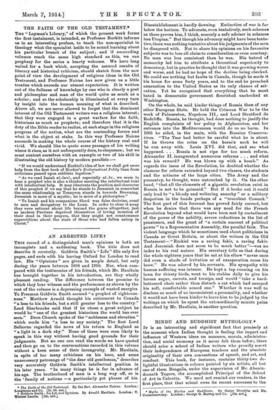HINDU AND BUDDHIST MYTHOLOGY.*
IT is an interesting and significant fact that precisely at the moment when Indian thought is feeling the impact and influence of Western ideas on manners, morals, administra- tion, and social economy as it never felt them before, there should arise a school of Indian writers who proudly assert their independence of European teachers and the absolute originality of their own conventions of speech, and art, and conduct. This book, for instance, contains thirty-two de- lightful illustrations in colours painted by six artists, all but one of them Bengalis, under the supervision of Mr. Abanin- dranath Tagore, the accomplished Principal of the School of Art in Calcutta. We need not remind our readers, in the first place, that that school owes its recent successes to the • Myth, of the Hindu. and Buddhists. By Sister Ntvedlta awl Dr. Coomatameamy. London: George G. Bann and Co. 01:0. net.1 inspiration of Mr. E. B. Havell, whose sympathy with Eastern methods of thought and expression taught him how a fertile compromise between Western and Eastern conventions might be accomplished. Before Mr. Havell showed the way, Bengali art consisted of crude and clumsy woodcuts or inferior imita- tions of Western models. Let any competent and kindly critic examine the drawings of Mr. Tagore and his pupils in this book, and they will see how subtly and intelligently indigenous art has been adapted to Western conventions of what is per- missible in pictorial representation. Take, for instance, the remarkable picture on p. 314 representing "Shiva drinking the World-Poison." This is the work of Mr. Nanda Lai Bose, one of the most original and daring of the new Bengal school, whose painting of the wicked Queen Kaikeyi and the dwarf Idantara is well known to all amateurs of modern Indian art. The divine ascetic has just drunk the deadly potion which would otherwise have been the bane of humanity at large. The artist has shown a minute blue spot on the throat of him whom Hindus call Nila-kantha. Not so would earlier and snore ingenuous artists have depicted the cerulean throat of the Himalayan deity. In nearly all the pictures in this book there is an obvious concession to Western ideas of decorum and restraint. The most courageously Hindu of the artiste is Mr. K. Venkatappa, whose name betrays his Dravidian origin. He alone ventures to represent the hero Rama as a blue being, as blue as an ancient Briton dyed with woad ; he alone makes the kindly monkey-folk, allies of Rama, as pink as any Sahib in the Civil Service. The others—and we are far from blaming them—obviously adapt ancient pictorial conventions to snit Western prejudices.
So is it also in the case of the letterpress which accompanies the illustrations. The ancient tales have been subtly Bowdlerized. This is, perhaps, inevitable. Anglo-Indians of many past generations have instinctively done the same thing in their own minds. They have bad delightful Hindu friends, wise, learned, and without reproach in every relation of life. They have known that such men have sought solace and in- struction in the vast and heterogeneous mass of the Hindu Scriptures. They have been led to read Ramayana and Mababluirata for themselves, and have not been surprised to discover much that is noble and inspiriting and beautiful em- bedded in huge crude masses of primitive and barbarous superstition. They have skipped the passages which tell bow the generation of Devas, as a brief example, " was thirty-three thousand, thirty-three hundred and thirty-three. The sons of Diva were Brihadbbinu, Chakshnsha, Atma, Vibhasu, &vita, Richika, Arks., Bhanu, Ashabaha, and Ravi." They have ignored things more primitive, more puerile, more monstrous than these. Their final memory of the Indian Scriptures has been not unkindly, and they have come to the conclusion that good men in all countries are better than the literal teaching of the mingled web of varied speculations of which the communal beliefs of mankind are made up. These obvious considerations would hardly be worth stating were it not that Hindu mysticism has a temporary vogue in Europe at present. Let us admit with Dr. Coomara- swamy that Hindu speculations " include much that mast very soon be recognized as belonging not only to India." But it is not necessary to go on to assert that Miss Noble (the "Sister Nivedita " of this volume) was "the inspiration of a new race of Indian students, no longer anxious to be Angli- cized." As a matter of fact, Miss Noble could not have taken so genuine and kindly an interest in Indian mythology if it had not been sedulously Anglicized for the benefit of her and her like. Dr. Coomaraswamy hopes that the book will be useful to "Civil servants and missionaries?' They bad much better read the Mahribluirata and Ranniyana in the original or in literal translations. It will do them no harm if they also peruse the Purtmas and Tantras, translations of which into the modern vernaculars enjoy a wide sale among those Indians who are not Anglicized. A glance at p. 331 of this book will show, even in this expurgated rendering of Hindu mythology, why the cult of Manua Devi, the snake-goddess, is still popular in Eastern Bengal. The book has its interest and importanee, and the pictures are, in some cases, not with- out a real charm of inspiration. It may serve to explain bow much the poet Rabindranath Tagore owes to his Western education, and in what real and salutary sense his remark- able talent has become, if we must use an ugly word,, Europeanized.















































 Previous page
Previous page